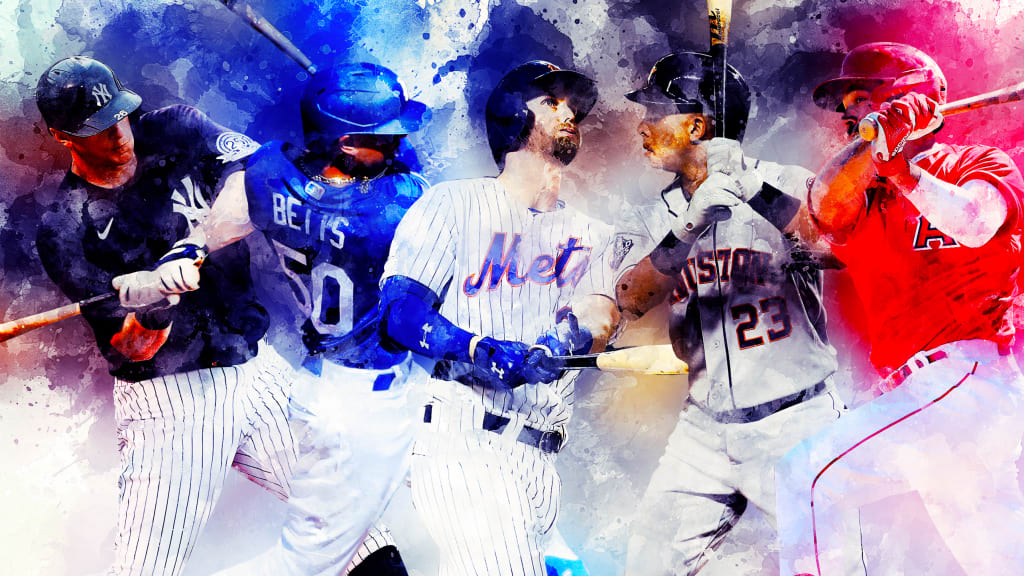
Scouts have long graded position players on five tools that are central to success in the game: Hitting, hitting for power, running, fielding and throwing. The so-called “five-tool player” is a special breed, as those who truly rate as above average in each category are extremely rare.
This week, MLB.com is tasking five reporters with building the ultimate five-tool Superman, by picking the best examples of each tool from the talented pool of current big leaguers. One important stipulation: Each player could only be selected for one of the five tools.
First up: Hit tool
If a player is going to have only one plus tool, this is the best option, the key building block for any position player.
Power is important, but you can’t homer without making contact. And even a player who is a plus runner, defender and thrower may struggle to hold down a regular starting job if he can’t hit.
This tool is generally understood to represent the ability to hit for average, by making contact and putting the ball in play. At least some would consider plate discipline and approach to factor in here as well. Your prototypical king of the hit tool minimizes strikeouts and excels in getting the bat on the ball in all parts of the zone, spraying line drives to all fields. Think Tony Gwynn or Ichiro Suzuki.
Here are the five picks among today’s players:
DJ LeMahieu, 2B, Yankees
Key stats: .313 BA / .309 xBA since '15
LeMachine is a perfect nickname for LeMahieu. He's a hitting robot. He hits at Coors. He hits at Yankee Stadium. He hits anywhere. The hit tool is in his code.
Over the last five years, which include a batting title in Colorado and a near-batting title in New York, LeMahieu is a .313 hitter. That's second to only José Altuve. Since 2015, LeMahieu's expected batting average (xBA) -- which is based on his quality of contact -- is .309. That's second to only Christian Yelich, and just a single point behind. So LeMahieu gets stat sheet results at an Altuve level, and he squares the ball up at a Yelich level.
And let's just focus on the 2019 version of LeMahieu for a second. His .327 batting average was fourth in MLB among qualified hitters. His .322 xBA was second-best, one point behind Cody Bellinger. He had 245 hard-hit balls (that means hit 95 mph or harder), second-most in MLB behind only Rafael Devers. And no one made hard contact more often than LeMahieu -- 37.4% of his plate appearances ended with him ripping a hard-hit ball, the highest rate in MLB. Plus, just for pure watchability, it's fun to see someone crack line drive after line drive into the opposite-field gap for a change, instead of go pull-homer-or-bust.
-- David Adler
Anthony Rendon, 3B, Angels
Key stat: .313 xBA since 2018
The Angels committed $245 million over seven years to add this bat to their lineup this offseason, and for good reason. Simply put, Rendon does everything you want a hitter to do at the plate. He’s selective. He puts the bat on the ball. And when he does so, it’s with authority.
In each of the past three seasons, Rendon has made contact on more than 90% of his swings against pitches in the strike zone, compared with the MLB average of around 82%. In 2019, Rendon (91.9%) ranked seventh in the Majors in that category, and 15th in lowest strikeout rate. But he’s not sacrificing pop for contact. Rendon had an 88th-percentile hard-hit rate last year, excels at getting the ball in the air and hits to all fields.
Add it all together, and you’ve got the only qualifying player to bat at least .300 in each of the past three seasons. Since 2018, Rendon’s .313 expected batting average -- which factors in strikeouts and quality of contact -- trails only Yelich. You don’t do that unless you’re consistently a tough out. Rendon, who never appears anything other than calm and balanced at the plate, fits the bill.
-- Andrew Simon
Jeff McNeil, INF/OF, Mets
Key stats: 81.4% career contact rate / .344 BABIP
With McNeil, it’s always been all about contact. From his first foray into the Majors in July 2018, the scouting report always said: swings at a lot of pitches, makes a lot of contact. And so far, 815 plate appearances into his career, that has rung quite true.
He’s swung at 58.9 percent of pitches he’s seen thus far, the second-highest swing rate among 96 batters to see at least 2,000 pitches since his debut. But he isn’t just swinging wildly -- he’s making contact. McNeil has an 81.4 percent contact rate in his career. That’s well above the Major League average of 74.8 percent, and ranks 23rd of 126 players with at least 1,250 total swings since his debut.
The thing about McNeil’s frequent swings and subsequent contact is that it’s quite successful. He had a .344 BABIP in his career, tied for seventh-highest among qualified hitters since the date of his debut. It isn’t just that he’s making contact -- it’s that he’s getting a lot of hits when he does it. Thus, his .321 batting average. He’s gotten results, and gotten a ton of hits.
-- Sarah Langs
Michael Brantley, LF, Astros
Key stat: 90.7% contact rate since 2018
When it comes to putting the ball in play, few do it more often than Brantley. In an era when strikeouts have skyrocketed around baseball, the outfielder has held steady, posting a lifetime 10.6% K-rate and hitting .297. Brantley rarely chases pitches out of the strike zone, and when he sees something he likes, he rarely misses. Over the past two seasons, he has made contact on 94.9% of his swings on pitches in the zone, the highest mark in the game, and 90.7% of his total swings.
With a simple, compact stroke, Brantley hits line drives all over the field, which makes it difficult for opponents to use the shift against him. In 2019, the left-handed hitter's line-drive rate was 28.1% (25.1% was the MLB average) and his 179 hits were evenly distributed -- 72 pulled, 57 to the opposite field and 50 up the middle. Brantley isn't just a singles hitter, though. The outfielder was one of 15 big leaguers with 40-plus doubles last season, and he added 22 homers.
-- Thomas Harrigan
Mookie Betts, RF, Dodgers
Key stat: 438 hard-hit sweet spot balls in play since 2016
A good hitter goes up to the plate looking to club a hard line drive. Over the past four seasons, Betts is tied with Manny Machado for producing the most hard-hit balls in the sweet spot zone (95-plus mph exit velocity and 8-32 degree launch angles, aka liners and dangerous fly balls). If it goes over the wall, great; Betts has averaged 29 homers a year in that span.
But along with that pop, Betts always puts pressure on pitchers by making them come to him. Only six full-time players have chased less than Betts since 2016, and he’s hit .340 against pitches that come into the strike zone. Betts owns fastballs, and he’s raised his average against breaking balls in each of the past three seasons, hitting an even .300 against them in ‘19. He’s extremely disciplined, and he’s adept at turning on a pitch to the pull side when pitchers finally make a mistake.
-- Matt Kelly




